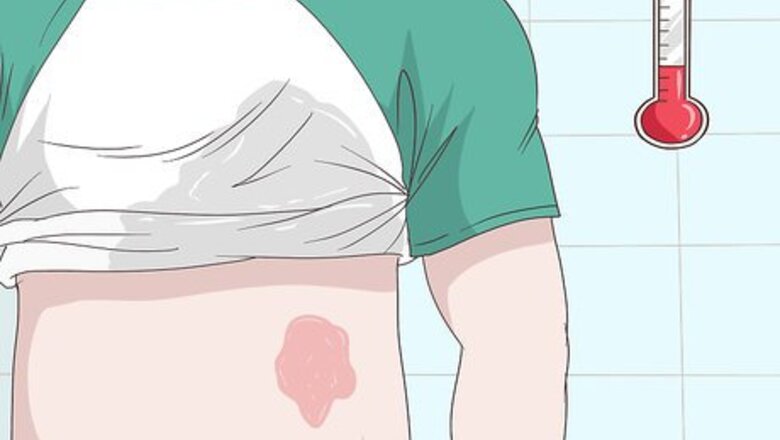
views
Treating a Minor Ice Burn at Home
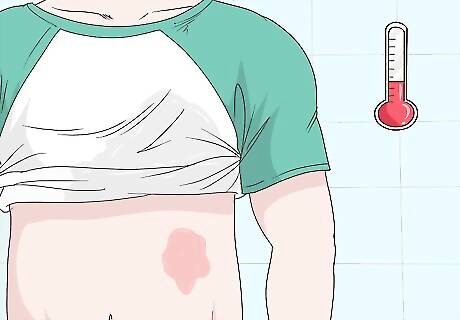
Remove the source of cold from your skin. If you think that you have an ice burn, immediately remove the source of cold from direct contact with your skin. If you have an ice burn due to high altitude and/or exposure to cold winds, return to a lower altitude and cover your skin with extra layers as soon as you can safely do so.

Take off any wet or cold clothing. Once you have removed the source of your ice burn, take off any wet or cold clothing that may prolong your exposure to cold. Your goal is to safely get your body, particularly the impacted area, back to a normal temperature as quickly as possible.

Soak the burned area in warm water for 20 minutes. To start treating your ice burn, heat up a bath, sink, or pot of water until it’s warm but not boiling. The water should be between 99 °F (37 °C) and 104 °F (40 °C). Submerge the impacted skin area into the warm water and let it soak without removing it for 20 minutes. Avoid using water above 104 °F (40 °C), as extreme heat can make your ice burn worse. As your skin soaks, you may experience a prickling sensation. This indicates that your skin is thawing and that the sensation is returning.
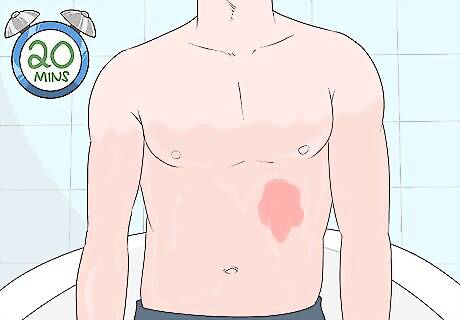
Remove your ice-burned skin from the soak for 20 minutes. After soaking for 20 minutes, remove the impacted skin area from the warm water soak and let it sit at room temperature for another 20 minutes. This will give your skin time to start to return to its normal temperature. After 20 minutes out of the soak, if you find that your burn has started to heal and the pain has started to subside, you may not need to repeat the soak. Room temperature is generally considered to be 70 °F (21 °C). If you are unable to rest in a room at around this temperature, cover your ice burn loosely with a blanket or extra clothing.

Repeat the warm water soak if your skin is still cold. After 20 minutes at room temperature, if you are still experiencing symptoms of an ice burn, re-heat your water to repeat the 20 minute warm water soak. If you repeat the 20 minute warm water soak, wait another 20 minutes after you get out of the soak before moving on to the next step. If your symptoms do not subside after a second soak and 20 minute rest, contact a medical professional immediately.
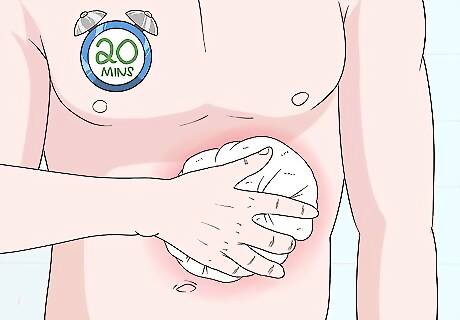
Apply a warm compress for about 20 minutes. If your symptoms have begun to subside after 1 to 2 warm water soaks but your skin is still a bit numb or cold, gently apply a warm compress to the burned area. Hold the compress on the burn for about 20 minutes. For your compress, you can use a hot water pouch, or run a wash cloth under hot water until warm. If holding a warm compress on the burn is painful, place your burned skin gently under a warm blanket instead.
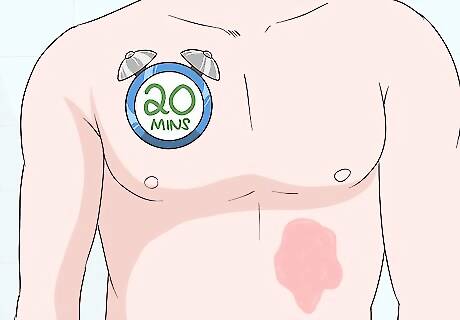
Remove the compress to let your skin return to its normal temperature. After holding a compress on your ice burn for about 20 minutes, remove the compress. Let your skin rest in room temperature until the impacted area has returned to your normal body temperature.
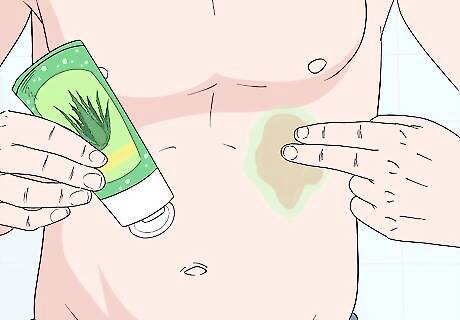
Use an aloe vera ointment if the burned skin is not cracked or broken. Apply an aloe vera ointment generously on top of the ice burned skin as often as 3 times per day. This can soothe the burn and decrease your recovery time by helping your skin retain moisture. Aloe vera may also help your skin form new cells quicker.
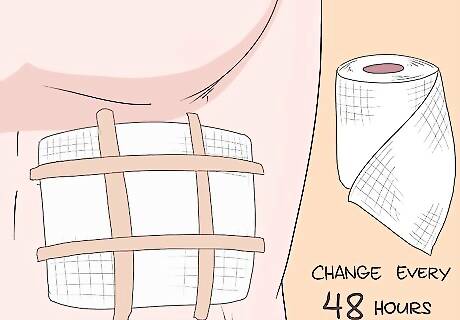
Cover the burn loosely with medical gauze. To protect the ice burn from germs or further irritation, use medical gauze and tape to keep the burn covered. Make sure that you don’t tape the gauze down too tightly – you want your burn to be able to breathe. To keep your wound clean, make sure that you change the gauze every 48 hours. When you change the gauze, you can rinse the burn gently with room temperature water to clean it and reapply aloe vera as needed. Keep your ice burn covered until it is almost completely healed and the pain has subsided. Minor ice burns should heal completely within 2 weeks.
Getting Medical Treatment for a Severe Ice Burn
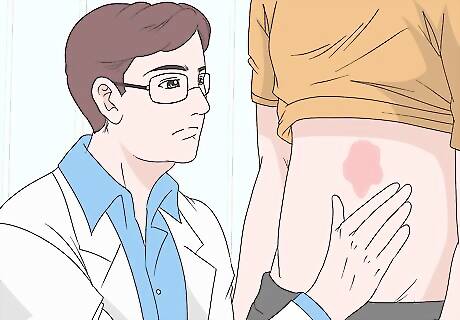
Seek treatment from a doctor if your ice burn symptoms are severe. Check your ice burn for the symptoms of a severe burn and see a doctor immediately if you exhibit any of the symptoms. Common symptoms for a severe ice burn include cracking or blistering, white, grey, or yellowish skin tint that remains even after your skin has warmed up, and/or the feeling of numbness, extreme cold, or hardening even after warming. In very severe cases, you might also experience an inability to use your muscles in the affected area. You may also notice the signs of an infection, including pus or green discharge, fever, and/or increasing pain. While it is possible for minor ice burns to blister and crack, this is generally an indication that your ice burn is severe. Even if your ice burn is minor, cracking and/or blistering can prevent you from being able to properly clean and care for the wound. Therefore, you should seek medical attention if your wound is open, regardless of the cause or severity.
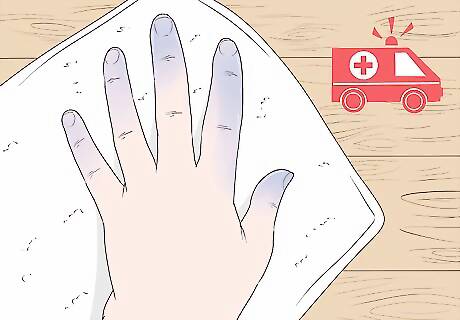
Seek emergency care if you also have frostbite. If your skin turns black or blue, or if you are in severe pain that penetrates deep into your body, you may also be experiencing frostbite and need to see a doctor immediately. The difference between an ice burn and frostbite is often very subtle. While an ice burn causes painful burning on the surface of your skin, frostbite occurs when both your skin and the tissue beneath it freeze and are damaged. While both ice burns and frostbite can cause your skin to turn white, red, or pale yellow, generally, only frostbite will turn your skin blue or black. Don’t rewarm frostbitten tissue if there is a possibility of refreezing before reaching emergency care. Don’t rub the frostbitten area because it could cause further tissue damage.
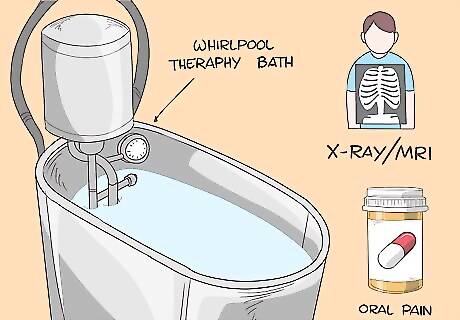
Receive treatment to address your specific symptoms. The treatment that your doctor administers will depend on the severity of your ice burn, whether you also have frostbite, and the symptoms you are exhibiting. In most cases, your doctor will begin by rewarming the skin using a 20-minute warm water bath or whirlpool therapy bath. Your doctor will also likely provide oral pain medication, infection-fighting medication, and possibly an IV with medication to help restore blood flow to the impacted area. If both the skin and tissue are damaged, your doctor may also perform a procedure to remove some or all of the burned area. In severe cases, your doctor may also conduct an X-ray, bone scan, or MRI to determine the extent of the damage. A severe ice burn can take anywhere from a few weeks to several months to heal. If you also have frostbite, it is possible that the impacted area will never fully recover.



















Comments
0 comment